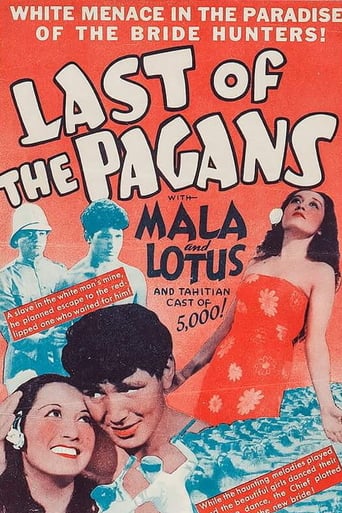Ketrivie
It isn't all that great, actually. Really cheesy and very predicable of how certain scenes are gonna turn play out. However, I guess that's the charm of it all, because I would consider this one of my guilty pleasures.
ChampDavSlim
The acting is good, and the firecracker script has some excellent ideas.
Teddie Blake
The movie turns out to be a little better than the average. Starting from a romantic formula often seen in the cinema, it ends in the most predictable (and somewhat bland) way.
Nicole
I enjoyed watching this film and would recommend other to give it a try , (as I am) but this movie, although enjoyable to watch due to the better than average acting fails to add anything new to its storyline that is all too familiar to these types of movies.
maxvaughn
I have a sort of on-the-fence feel about this film. I know this is a result of its time, including clichés of the Polynesian people that you have to take with a grain of salt. The 1930s were not exactly a time period of embracing diversity and fighting against racism. It also includes certain tropes of adventure movies that are sexist, such as the main male character Taro kidnapping his bride Lilleo from another island because "that's what his tribe does". Followed by her falling in love with him through what is basically Stockholm Syndrome. That being said, this is one of the few early Hollywood movies I have ever seen which tried to show the abomination of enslaving a group of people. It doesn't do it well, but it gets a C for effort. The film shows everything through the eyes of Taro and the other Polynesians. You see their lives and hear their language (which was probably a Hollywood, bastardized version of a Polynesian language- I'm not entirely sure). They are simply people living out their daily lives, although their daily lives are made out a little like a travel brochure. You see the way the islanders are tricked by by the mining company and then worked to exhaustion. Despite the cheesy romance and rather slapped together ending, this has the underlying message of the cruelty of stealing another person's life for greed. Overall, it is still tame in comparison to history. Also, I understand this is credited as being, in part, based on Herman Melville's Typee, but I really didn't see many similarities except for a few of the customs of the islanders. All in all, it is a beautifully photographed movie and deserves some recognition for it's attempt to be different in its storytelling.
mauvemoonlight
I recently had the opportunity of viewing this film. It is in black and white and was made quite some time back, but is well worth seeing.Concerning French Polynesia, much of the dialogue is non-English, and the translations are a bit scarce; but not needed much--the actions of the characters and what happens to them tells the story quite adequately.The native men from one island go to another island to steal wives for themselves. The main male character, Taro, kidnaps a woman he especially fancies. She is very unhappy about this--and I fully expected him to drag her back to his island and immediately start raping her, but that is not how it happens. Instead, once he gets there, he courts her-and she begins to become quite taken with his charms.However, there are white men looking for labor for their mines, and the chief in Taro's village is also taken with the woman Taro wants. You can be sure these things come to plenty of troubles for both Taro and his intended.This film was quite different from any I have ever seen before. It was excellently done and well told and I would certainly recommend it.
boblipton
This is one of those Romances of the South Seas that MGM liked to offer its patrons every year or so. This one is based on Herman Melville's TYPEE, which I was spared in college and never got around to reading on my own.I'll take a moment to speculate that the reason Melville was so adaptable to the movies was that at the heart of his boring, obsessively-detailed novels, there was always a good adventure yarn. Screenwriter John Farrow has whittled this one down to a Rousseau-style Romance of the Noble Savage. The Polynesian lovers are played by Mala, who was an Inuit, and Lotus Long, who hailed from exotic Atlantic City. Richard Thorpe, beginning his long career for Metro, got good performances out of the leads, who speak in what I guess is a Polynesian language, extensively subtitled. They undergo courtship, traders who kidnap Mala to work in a collapsing guano mine, and a big storm. Will true love be denied? While the screenplay is hobbled by the Production Code, the photography is superlative, shot by location specialist Clyde de Vinna. If you can turn your ears off, you'll see a fine little silent film here, with some spectacular views.
John Seal
Last of the Pagans features some quite stunning black and white photography by Clyde De Vinna and a paper thin story designed to please those who like travelogues with a touch of romance. Shot on location in Tahiti, the film is a lightweight take on the Robert Flaherty oeuvre, with numerous tips of the hat to the great documentarist's features, especially his 1926 South Seas epic Moana. Mala--an Alaskan native discovered by director W.S. Van Dyke during production of the similar Eskimo (1933)--plays Taro, the male chauvinist pig who steals beautiful Lotus Long from her native village and claims her as his own. Last of the Pagans is a relentless parade of cultural imperialism and cliches about primitive peoples and noble savages, but it looks absolutely gorgeous. You're best advised to turn the sound down, ignore the subtitles, and soak up De Vinna's superb camera work.

